|
Volume 25, pages 46-68, 1940
PEGMATITE DIKES OF THE BRIDGER MOUNTAINS, WYOMING*
THAD G. McLAUGHLIN, University of Kansas, Lawrence, Kansas.
CONTENTS
ABSTRACT.............................................................................. 46
INTRODUCTION.................................................................... 47
COUNTRY ROCK................................................................... 49
Pre-Cambrian.......................................................................... 49
Area..................
................................................................... 49
Description................
........................................................... 49
Structure............................................................................... 50
History
................................................................................. 50
PEGMATITE DIKES................................................................. 51
Distribution............................................................................... 51
Age.......................................................................................... 51
Older Dikes..............
.............................................................. 52
Description............................................................................ 52
Structural relationships.......... .......
................................ . ..... 53
Contact
metamorphism.......................................................... 53
Mineral
descriptions............................................................... 54
Younger Dikes............................
............................................ 55
Description...............
............................................................ 55
Structural relationships..........
................................................ 56
Contact metamorphism............................. ............................ 56
Mineral
descriptions............................................................... 56
Zoning
..................................................................................... 60
Banding.............. ..... ... . .......................... .................
............ 62
Paragenesis............ ..............
................................................... 64
REPLACED
SCHIST.................................................................. 65
HISTORY OF MINERALIZATION ......... ................................ 67
REFERENCES........................................................... ................ 68
ABSTRACT
The central area of pre-Cambrian rocks in the Bridger Range of central Wyoming
consists predominantly of black hornblende schist. The schist has been invaded
by large masses of coarsely crystalline granite. The granite invasion was
followed by two distinct intrusions of granite pegmatite. The older pegmatite
dikes were intruded along a steeply-dipping joint set which is parallel to the
plane of foliation of the schist. The younger pegmatite dikes have a lesser dip
and were intruded along a joint set which was formed subsequent to the intrusion
of the older dikes.
The intrusion of the older dikes was followed by an invasion of silica-rich and
potash-rich hydrothermal solutions which replaced the black schist with quartz
and sericite. The intrusion of the younger dikes was followed by an invasion of
hydrothermal solutions which partially replaced the original dike minerals and
precipitated cleavelandite, muscovite, tourmaline, beryl, garnet, columbite,
tantalite, chalcopyrite, lepidolite and petalite.
Several of the hydrothermal minerals were deposited in parallel bands which
strike and dip nearly parallel to the strike and dip of the dikes. The
semi-concentric arrangement of these bands and their uniform parallel
arrangement indicates a rhythmic precipitation similar to "Liesegang
rings."
After a removal of the overburden by erosion, several supergene minerals were
formed, including quartz, sericite, malachite and limonite.
The purpose of this study was to determine the history of the country rock, the
structural relationships between the dikes and the country rock, the relative
ages of the two types of dikes, and the paragenesis of the minerals within the
dikes.
INTRODUCTION
The area which was studied lies in the northeast part of Fremont County near the
center of the state. The pegmatite dikes that were mapped are intruded into the
pre-Cambrian rocks east of the Wind River Canyon. They are 15 miles northeast of
Shoshoni and about 20 miles southeast of Thermopolis. Field studies were made
during the summers of 1936, 1937, and 1938, and were supplemented by laboratory
work in the spring of 1937 and the fall and winter of 1938.
A map of sections 27 and 28, range 93 west, township 40 north, was made by a
plane table survey in which both the geology and topography were mapped. The map
shows the topography, with a contour interval of 20 feet, and the areal geology.
Rock types mapped include the pre-Cambrian schist, pegmatite dikes, and
Pleistocene (?) alluvium.
I wish to express my sincerest thanks to K. K. Landes and H. T. U. Smith for
the help rendered in the field, in the laboratory, and in the theoretical
discussions. Mr. LeRoy Fugitt, Mr. Bruce F. Latta, and Mr. Kenneth E. Corr
assisted in the field work during the summers of 1936, 1937, and 1938,
respectively. Mr. Ed Crabb and Mr. Denny Thoren of Shoshoni and Mr. Val B.
Maghee of Lander furnished valuable information about the area studied.
The first mining in this area was done in 1906 when Mike Crowley filed a claim
in dike 85. Some mica was taken out, but the project was soon abandoned. The
present claimants, Jake Stephenson and others, filed in 1910 and mined a small
amount of feldspar, beryl, and mica in dikes 3, 7, 25, 81, and 85. One of the
claimants leased and did some work on dike 7 in 1928, taking out feldspar and
lepidolite. The claims at present are leased by Mr. Val B. Maghee of Lander,
Wyoming, who has been working on dike 86 since early in 1937 and has marketed
several hundred pounds of tantalite. He is also mining beryl from the same dike. 
COUNTRY ROCK
PRE-CAMBRIAN
AREA
The pre-Cambrian rocks outcrop in a roughly triangular area nearly 20 miles long
and 10 miles wide, elongated in an east-west direction. They are also exposed
several miles west of this area in the bottom of Wind River Canyon in a
triangular area 1 mile wide and 12 miles long (6).
DESCRIPTION
The black country rock is a fine grained schist composed dominantly of
hornblende and labradorite. The schist resembles a fine grained igneous rock,
but the crystals are elongated parallel to the schist's foliation. Thin sections
of the country rock show that it is a hornblende schist.
Hornblende constitutes 70 to 85 per cent of the schist. It occurs in elongated
lath-like subhedral crystals, which are crossed and interpenetrating. The color
in thin section, because of strong pleochroism, varies from light to medium
blue-green. The laths are 0.1 to 0.5 of a millimeter long and generally about
one-fifth as wide. A few crystals of hornblende are slightly altered to
chlorite. The labradorite variety of plagioclase feldspar constitutes 10 to 20
per cent of the black country rock. It forms irregular masses and subhedral
crystals with prominent albite twinning lines. It is colorless and has a low
relief and low birefringence. The individuals were generally 0.8 to 1.0 mm. in
diameter. Common accessory minerals are magnetite, chlorite, quartz, actinolite
and zircon. None of these minerals ever constitute over two per cent of the
rock. Magnetite forms very irregular masses which are subrounded, tabular, or
trellis-like. It is often slightly altered to hematite and limonite which are
nearly opaque to transmitted light, but are reddish brown to ocher yellow in
reflected light.
Many thin sections of the country rock contain a very fibrous or asbestiform
mineral, which is probably an alteration of hypersthene to actinolite. The
fibers are very coarse and irregular to wavy. Pleochroism is very strong, with a
color variation from pale grayish brown to brownish black. The birefringence is
high, but the colors are slightly obscured by the color of the mineral. Zircon
is present in every thin section that was made of the country rock. It may be
rounded, ellipsoidal, or rod-like with rounded ends. The extinction is parallel,
the relief and birefringence are very high, and the color is gray to colorless.
The granite outcrops in the eastern third of the pre-Cambrian area. It is a
medium to coarse-grained rock containing over 90 per cent pink feldspar with only a small amount of quartz and muscovite. Near the
granite-schist contact the granite has a gneissic structure and a much greater
percentage of muscovite and quartz. Joints extend from the granite into the
schist without offset. The granite erodes into rounded knobs and hills of small
relief. Granite also outcrops in Wind River Canyon (6) and near Birdseye.
STRUCTURE
The schist in this area has very distinct foliation and jointing. The strike and
dip of the foliation of the schist varies considerably from one locality to
another. The strike is "not more than 10° from east to west" in Wind
River Canyon (6 p. 1419), but in the two sections that were mapped the strike
varied from S. 40° W. to S. 83° W. with an average of S. 60° W.
The dip of the foliation in Wind River Canyon ranges from 30° to 60° S. with
an average of 45° S. (6 p. 1419) while in the area that was mapped, the average
dip was 66° S. with a maximum of 70° S. and a minimum of 58° S. The jointing
in the schist dips against the foliation of the schist. The dip varies from 40°
to 50° N. with an average of about 45° N. It is along these joints that many
of the pegmatite dikes were intruded. The granite in the eastern part of the
pre-Cambrian area, and many of the larger pegmatite dikes, also show distinct
jointing.
HISTORY
A considerable controversy has taken place concerning the origin of hornblende
schist and similar metamorphic rocks. Many conclusions have been based on the
presence of quartz, the range of the plagioclase feldspars, and the physical
properties of the zircon grains.
The zircons in some hornblende schists are smoothly rounded spheroids and
ellipsoids, which closely resemble the rounded grains in sedimentary rocks. It
has been inferred by some that. this is sufficient proof of a sedimentary
origin. Later investigators have pointed out that many of the zircon grains are
oblong as well as rounded, and that rounded grains can be found in igneous
rocks, such as diorite, dolerite and basalt (22). Zircon crystals from the
Bridger mountain schists have length to width ratios as high as 8 to 1. Grains
of such shape are probably not of sedimentary origin.
Carlson (3) believes feldspar and quartz are indicators of the former character
of metamorphic rocks. A narrow range in the plagioclase feldspars is indicative
of an igneous origin, for derivation from sedimentary rocks would result in a
wide range in plagioclase feldspars, and also an excess of quartz.
The schists of the Bridger Range contain elongate grains of zircon, have a
narrow range of plagioclase feldspars, and are almost devoid of quartz. These
criteria point to an igneous origin, probably from a diorite or basalt.
The red, coarse-grained granite at the east end of the pre-Cambrian area was
intruded after the formation of the black schist, for it shows very few signs of
regional metamorphism. One jointing system passes through both schist and
granite, which means that this granite is older than the nearby pegmatite dikes
which were intruded along the jointing system in the schist.
Another area of red granite is exposed near Birdseye at the Gold Nugget mine.
The pegmatite dikes in this locality have been intruded into the schist parallel
to the near-vertical jointing system. These dikes also intrude the red granite
which is probably the source of the later pegmatite dikes.
PEGMATITE DIKES
DISTRIBUTION
The black schist in Wind River Canyon and in the pre-Cambrian area east of the
canyon has been invaded by many granite pegmatite dikes. These dikes outcrop in
all parts of the schist area and in the granite area near Birdseye, but none
were found in the granite at the east end of the pre-Cambrian area.
The simple dikes (those which have not suffered later hydrothermal replacement)
are evenly distributed throughout the area of black schist. Most of them strike
and dip concordantly with the foliation of the schist, but a few in Wind River
Canyon are parallel or subparallel to a joint system which dips against the
foliation.
The complex dikes, all of which dip in a direction opposite to the dip of the
foliation of the schist, are concentrated in a small area on the south side of
the mountains in range 93 W. Most of them were included in the map of sections
17 and 28. Dike 86 is the only dike containing hydrothermal minerals that does
not lie in either of these two sections. It outcrops in the southeast quarter of
section 21.
AGE
The pegmatite dikes are truncated by the Deadwood sandstone in Wind River
Canyon. This indicates a pre-Cambrian age for the dikes. The relationships of
the pegmatite dikes and the Paleozoic sediments are not readily observable
along the south side of the Bridger Range because of the extensive overlap of
the Wind River formation. The writer was unable to find any dikes that were
intruded into sedimentary rocks.
OLDER DIKES
DESCRIPTION
The older dikes in this area are those which strike and dip parallel or
subparallel to the strike and dip of the schist's foliation. Only 19 per cent of
the dikes in sections 27 and 28 are of this type. Many of these dikes are small
parallel bands intruded in a lit-par-lit manner. Others are large, coarsely-crystalline masses. Dike 38 is 50 meters wide and 170 meters long. The
large area of altered schist adjacent to this dike indicates that if the dike
were entirely exposed it would be nearly 350 meters long. Nearly 50 per cent of
the older dikes are more than 35 meters in length and 90 per cent of them are 20
meters or more long.
The older dikes are all elongated bodies but where insufficient country rock has
been eroded from the dike the outcrop area may be roughly circular. One can
roughly determine the actual dimensions of the dike, however, by measuring the
length and width of the zone of altered schist which invariably overlies the buried part of the dike. The length is always 5 to
10 times as great as the breadth.
STRUCTURAL RELATIONSHIPS
The average strike and dip of the dikes is S. 61° W. 65° S., which is almost
identical to that of the foliation of the schist (S. 61° W. 66° S.). The
strike of the dikes ranges from S. 40° W. to S. 80° W. The maximum dip of the
dikes is 70° S. and the minimum dip is 58° S. The strike and dip of the dikes
coincide much more closely with the strike and dip of the foliation in this area
than they do in Wind River Canyon.

FIG. 2. Older dikes intruded parallel to the foliation of the schist.
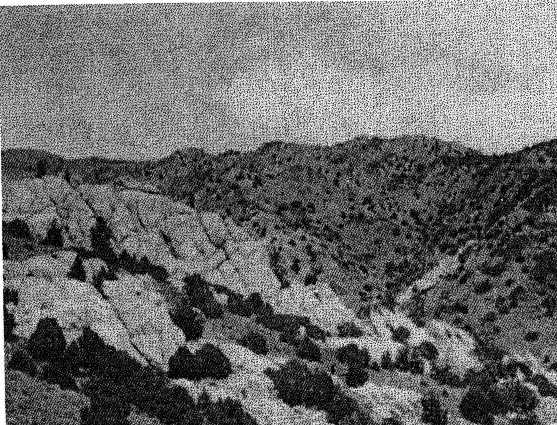
FIG. 3. Jointing in the older dikes.
CONTACT METAMORPHISM
The intrusion of the older pegmatite dikes was accompanied by alteration of a
large amount of country rock. The altered zone always lies above the dike and
never extends more than one meter on either side of it. Silica-rich solutions,
which travelled beyond the dike itself, followed the easiest passageway, which
was parallel to the foliation of the schist. Thin sections of this altered
country rock show considerable change from the original hornblende schist by the
addition of a large amount of quartz and some muscovite. Hornblende and
plagioclase, and the accessory minerals magnetite and zircon are present. The
percentage of hornblende is greatly reduced and quartz is the predominant
mineral.
Megascopically, the metamorphosed schist is brown to brownish green. It is more
micaceous, softer, less brittle, and can be readily distinguished from the
original black schist even* at a considerable distance.
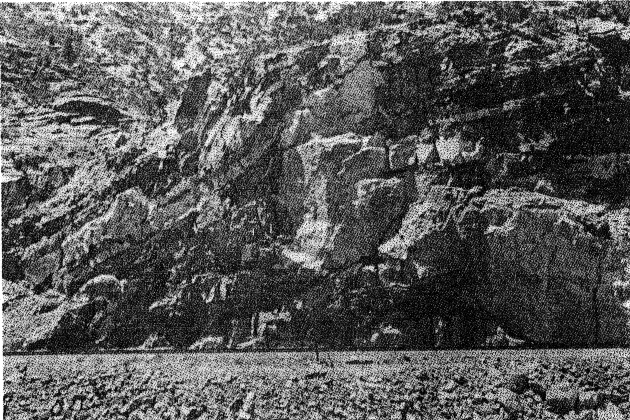
FIG. 4. Pegmatite dikes in the black schist in Wind River Canyon. (Photo by H.
T. U. Smith)
MINERAL DESCRIPTIONS Microcline. The most abundant mineral in the older dikes is microcline. It
constitutes more than 70 per cent of the rock which is made up entirely of
quartz and feldspar. The microcline is dominantly white but may also be various
shades of gray, light blue and rarely pink. It is coarsely crystalline with some
individuals more than a meter in diameter. No euhedral or subhedral crystals
were observed. A perthitic intergrowth of albite and microcline was found in
several dikes. The color of both the albite and microcline is white, making the
perthite difficult to distinguish from the specimens of pure microcline. Quartz
is the most common mineral associate of microcline but tourmaline may rarely be
present where a younger dike transects an older one.
Quartz. Quartz is next in abundance and constitutes almost 30 per cent of the
rock in the older dikes. It is always anhedral and its color is generally pale
milky but locally is dull gray. The quartz is evenly dispersed throughout the
dike and is seldom concentrated in lenses as it is in the younger dikes. It
frequently forms veins, varying in width from 1 to 30 cm. which penetrate the
country rock in a lit-par-lit manner. These veins often contain a small amount
of microcline. Tourmaline. Black tourmaline is found in an older dike (no. 28) where it is cut
by a younger dike which dips in a direction opposite to that of the foliation of
the schist. The tourmaline-bearing solutions obviously came from the same parent
magmas as the younger dike. These solutions followed the sides of the younger dike and deposited
tourmaline in small veins and clusters in both the older and the younger dikes.
The tourmaline is found in subhedral crystals less than 2 cm. long. These
elongated crystals cut both the quartz and the microcline.
YOUNGER DIKES
DESCRIPTION
The younger dikes are those that dip north against the foliation of the schist.
Eighty-one per cent of the dikes that were mapped in sections 27 and 28 are of
this type. These dikes outcrop only in a small area on the
south side of the Bridger Mountains near the contact of the black schist and
the alluvium. Most of the younger dikes are elongated, tabular masses with a
length 5 to 20 times as great as the thickness. The average thickness of the
dikes in sections 27 and 28 is 5 meters and the average length is 84 meters. The
mean ratio of length to thickness is 16 to 1. The feldspar in the dikes is
white, gray, or pale blue and gives the dike a decidedly white color which is
amplified by the background of black schist. This contrast of color makes the
dikes visible for a great distance.
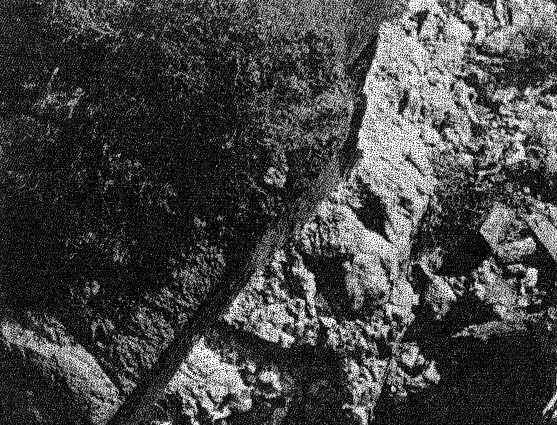
FIG. 5. Sharp contact of a younger dike with the country rock.
The younger dikes do not weather to any characteristic forms. There is no
distinct jointing, but the dikes fracture easily causing them to erode as
rapidly as the schist. The rate at which they erode is controlled by the rate of
weathering of the schist.
STRUCTURAL RELATIONSHIPS
One of the outstanding features of this area is the almost perfect control on
the position of the dikes exercised by the structure of the country rock. All of
the older dikes strike and dip parallel to the foliation of the schist.
Variations in strike and dip of these dikes is caused by variations in the
strike and dip of the foliation. All of the younger dikes have been intruded
parallel to the jointing in the country rock. The directions of jointing are
more uniform than the foliation of the schist, therefore, the strike and dip of
the younger dikes is more uniform than that of the older ones.
The maximum dip measured in sections 27 and 28 is 62° N. and the minimum is
30° N. The average of all the dips measured is 45.5° N. Eighty-five per cent
of the dikes dip to the north at an angle within 40° and 50°, and 50 per cent
of the dikes dip north at an angle within 3° of the mean (45.5°). The average
strike of the dikes is S. 43° W. which is nearly the same as that of the
foliation of the schist.
CONTACT METAMORPHISM
Metamorphic effects of igneous intrusion were noted in all but two of the
younger dikes. The otherwise hard, black hornblende schist has been altered to a
dark bluish-green, friable material which megascopically looks very different
from the original material. The contact of the altered schist with the unaltered
material is always a joint plane. The metamorphosed rocks are coated at the
surface by brown iron oxides. This has probably been caused by oxidation of the
iron in the schist to limonite, followed by incomplete dehydration to hematite
and perhaps turgite.
Microscopic examinations of thin sections of the metamorphosed material have
revealed very little mineralogical change from the original unaltered schist. It
contains over 70 per cent of hornblende, 5 to 15 per cent of quartz, and lesser
amounts of magnetite, actinolite, and zircon.
MINERAL DESCRIPTIONS Microcline. Microcline is the most abundant mineral in the younger dikes as well
as in the older ones, but the percentage is much smaller in the younger dikes.
The microcline in these complex dikes is white to pale blue and gray. It is
coarsely crystalline, some individuals being over 2 meters in diameter.
The dikes originally were intruded as liquid masses of microcline and quartz
with the quartz concentrated in irregular lenses at the center of the dikes and
microcline along both walls of the dikes. Later invasion and replacement at the
center and along the walls left only small zones of microcline about one-third
of the way in from each wall. Microcline is almost always found in these zones;
and in a few dikes where there is no quartz lens, it may be found at the center
of the dike.
Microcline is relatively soluble and has been attacked by hydrothermal solutions
and partially replaced by later minerals. Some individuals have been almost
entirely replaced by cleavelandite and muscovite. Perthitic intergrowths of
white albite and white to gray microcline were found in dike 25. They occur in a
narrow zone near the top wall of the dike. Quartz. Quartz is found in three places within the complex dikes: (1) in lenses
near the center of the dikes, (2) in a small zone near the walls of the dike,
and (3) rather evenly disseminated throughout the rest of the dike.
The quartz is white, milky, dull gray or, in a few instances, rose. It is always
anhedral. Dikes 79 and 82 are made up almost entirely of feldspar, but grade
into pure white quartz dikes or veins which stand above the rest of the rock
because of greater resistance to erosion. Conchoidal fracture is most common,
but a few specimens display a poor cleavage. The luster is vitreous, except for
the gray quartz which has a dull luster. Lepidolite. The lithium minerals are not very abundant. They were found in dikes
7, 11, and 86. The lepidolite was deposited in irregular zones at the center of
the dikes where
it is commonly associated with quartz, sericite and some cleavelandite. The
mineral occurs as small plates or thin books less than 6 mm. in diameter which
are rather evenly disseminated through. the central part of the dikes. The
plates are pale lilac in color, irregular in outline, and slightly fractured.
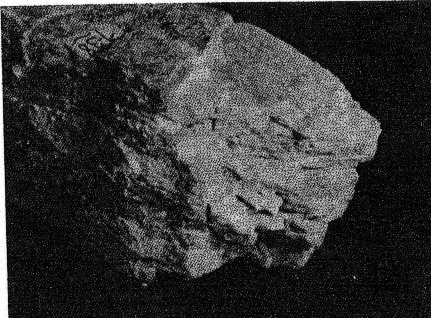
FIG. 6. Pseudomorph of albite after petalite. One-half natural size.
Petalite. Dike 86 is the only one where petalite was collected. However,
pseudomorphs of albite after petalite are rather abundant in dike 7. A lens of
milky quartz lies at the center of 86 and is overlain by a zone containing
cleavelandite and a pseudomorph of albite after petalite. The pseudomorph,
however, is absent from the zone of cleavelandite which lies immediately below
the quartz lens. Number 7 has no lens of quartz at the center, but there is
instead a belt of lepidolite, cleavelandite, and some sericite and quartz. This
central area is both overlain and underlain by a pseudomorph of albite after
petalite.
The petalite individuals are as much as 20 cm. long. They are extremely brittle
and therefore highly fractured. The cleavage is good both on c(001) and x(201).
The basal cleavage is not perfect as many textbooks describe it. The color and
diaphaneity closely resemble that of pale milky quartz except along the basal
fracture or cleavage planes where it is white and less translucent.
The replaced petalite resembles to some extent the original mineral. The basal
cleavage lines are very distinct (Fig. 6), but traces of cleavage along o(201)
are poor or absent. The cleavage plates are 1 to 3 mm. thick and are always
normal to the dike walls. The zones of replaced petalite lie immediately above
and below the central area of lepidolite in dike 7. These zones are very
irregular and are at no place more than 1.5 meters thick. Apparently the
replacement was complete for no specimens of residual petalite could be found.
Specimens collected from the Bridger Range closely resemble those from
Londonderry in Western Australia except that the former contain more sericite
and have preserved the original structures somewhat better.
Amblygonite. Although no amblygonite was collected from any of the dikes, it has
been reported by Mr. Maghee to be present in dike 7.
Cleavelandite. Cleavelandite is the most abundant hydrothermal mineral present
in the younger dikes. It is white to cream colored, but may be stained black by
manganese oxide. The cleavelandite is subhedral with individuals varying greatly
in size. The specimens having a sugary texture contain crystals as small as 1 mm. Several
crystalline aggregates taken from dike 7 were more than 15 cm. wide. They
consist of radiating tabular crystals of cleavelandite elongated parallel to the
side pinacoid. Albite twinning is noticeable.
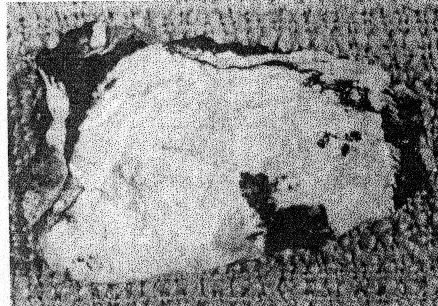
FIG. 7. Black tourmaline transecting cleavelandite. Three-fourths natural size.
The cleavelandite occurs in irregular zones near the walls of the dike. These
zones are very indefinite. A wide variety of minerals is associated with
cleavelandite, including microcline, quartz, muscovite, garnet, beryl, columbite
and tantalite. Tourmaline. The ordinary black variety is the only type of tourmaline found in
these dikes. It commonly occurs as elongated and striated crystals which were
deposited in small veins and lenses within the dike. The tourmaline bearing
solutions rose along the contact of the dikes and precipitated tourmaline
crystals both in the dikes and in the schist. The mineral is subhedral and very
brittle and is found replacing or cutting into quartz, microcline, cleavelandite,
and schist. Braunite. The mineral braunite always occurs in very irregular nodules
surrounded by coarsely crystalline blades of greenish muscovite. The nodules in
dike 85 were all found at or near the base of a large lens or band of muscovite and cleavelandite. The
mineral is dark brown to nearly black and is submetallic to earthy. The
submetallic part of a specimen generally shows good cleavage in one direction,
probably parallel to p(111). The earthy part is browner and breaks with an
uneven, slightly conchoidal fracture. Single nodules are as wide as 12 cm. but
the average is about 5 cm. Muscovite. The muscovite found in these dikes is pale green and highly
fractured. Hydrothermal solutions have deposited this mineral in three distinct
zones within the dikes: (1) at the contact of the dike with the country rock,
(2) in lenses between the quartz lode at the center of the dike and the upper
contact with the schist, and (3) in small books and flakes associated with the
cleavelandite.
Muscovite is comparatively resistant to attack and is only replaced by one
mineral, sericite. Small books of muscovite may be replaced along their borders,
and a few specimens show small veinlets of sericite cutting entirely across
books of muscovite. Apatite. Several small aggregates of anhedral grains were identified by oil
immersion methods as apatite. Such aggregates were never over 1 cm. wide, and
individual grains were less than 1 mm. in diameter. These sub-rounded grains
were all found in specimens collected from dike 25. However, much larger
individuals are reported by Mr. Maghee to have been found in dike 86.
The mineral is dark bluish-green, translucent, and shows a sub-vitreous luster.
In every specimen that contained apatite, the small grains were imbedded in a
mass of white saccharoidal cleavelandite with fine flakes of muscovite and a
small amount of residual pale milky quartz.
Beryl. Cleavelandite and muscovite are always associated with beryl. The beryl
may occur as light green to pale blue elongated euhedral prisms imbedded in the
cleavelandite zones near the center of the dike, or as aggregates of small blue
green anhedral blebs in the bands of sugary cleavelandite found in the banded
dikes. Some of the euhedral crystals of beryl are aquamarine and of gem quality.
The individuals vary in size from small rounded masses less than 1 mm. wide, to
euhedral prisms 20 cm. in diameter. The beryl crystals cut through masses of
sugary clevelandite, but are unaltered by any of the hydrothermal solutions.
Columbite-tantalite. Both the nearly pure niobate and the nearly pure tantalate
often are found in the dikes in this area. This mineral is found associated with
sugary cleavelandite in a zone just above the center of the dike. The zone
varies greatly both in thickness and in concentration of columbite-tantalite.
Only dikes 85 and 86 contain it in considerable quantities. Specimens belonging
at both ends of the isomorphous series occur in these two dikes.
Columbite is almost entirely confined to dike 85, but a few crystals were
collected from 86. It crystallizes in very thin tabular crystals elongated
parallel to a(100). The crystals are generally less than 1 mm. thick, about 1.5
cm. wide, and 5 to 10 cm. long. The most common forms present are two prisms,
brachypinacoid and macropinacoid. The mineral is also commonly in anhedral
masses with quartz and cleavelandite. Chemical analyses by the Fansteel
Metallurgical Corporation show that the columbite is very low in tantalum, and
that one specimen from dike 86 was almost pure columbite. It is always black and
displays a metallic luster. The specific gravity is 6.21, which is high for a
mineral of this series so low in tantalum.
Tantalite is much more abundant than columbite, but is almost entirely limited
to dike 86. A few euhedral crystals, which closely resemble those found in dike
86, were found in dike 7. Tantalite is in most cases euhedral, although a few
individuals are subhedral or anhedral. Crystals of this mineral are
equidimensional and maybe as large as 5 cm. in diameter, but have an average
width of 2 to 3 cm.
The luster is metallic and the color is generally black, but may be a medium
grayish brown when weathered. The specific gravity is 7.82, which indicates a
high per cent of tantalum. It has been shown (10) that in the columbite-tantalite
series the specific gravity varies roughly with the amount of Ta2O5.
Garnet. All of the dikes from which mineral specimens were collected contained
at least a small amount of garnet. This mineral occurs as irregular, reddish
brown anhedral, subhedral, or euhedral individuals with a vitreous luster.
Specific gravity measurements and chemical tests indicate that the variety is
spessartite.
Anhedral garnets with a dull luster were found in dike 7 where they occur in 2
to 10 cm. masses imbedded in cleavelandite. The small red and amber crystals are
most commonly associated with cleavelandite, but may be found with microcline.
The euhedral crystals contain both the trapezohedron and the dodecahedron. They
are found cutting into microcline, evenly disseminated throughout the zones of
cleavelandite, or concentrated into bands less than 2 cm. wide which dip
parallel to the dip of the dike. The anhedral garnets are roughly spheroidal
blebs most of which are smaller than a pin head. The garnet is very resistant to
replacement and is not altered or cut by any of the other hydrothermal minerals
in the specimens collected. Chalcopyrite. A 50 cm. vein of quartz and 35 cm. zone of microcline lie at the
center of dike 49. Many small irregular anhedral masses of chalcopyrite were
found in this part of the dike. This mineral has in many specimens been oxidized
to malachite, forming a green stain on microcline, quartz, and cleavelandite.
Supergene quartz. Cavities are very rare both in the simple and in the complex
dikes. One small cavity, which was less than 3 cm. in diameter, was found in a
specimen collected from dike 3. It is lined with subhedral crystals of quartz.
The crystals are very poorly developed, but show a prism and rhombohedral forms.
This quartz is undoubtedly supergene, having been formed after the deposition of
the hydrothermal minerals. Sericite. Sericite is commonly associated with the zones in which lepidolite,
cleavelandite, columbite and tantalite are found. It. was found in specimens
collected from dikes 7, 85, and 86. It has been deposited along the cleavage or
fracture planes of the pseudomorph of albite after petalite, in scattered flakes
and grains dispersed throughout the zones of lepidolite, and in small veins
cutting into and across books of muscovite. In some specimens the muscovite has
been so severely attacked by sericite that only a small part of the original
book remains. Malachite. The oxidation of chalcopyrite has produced a green stain of malachite
throughout dike 49, although the primary sulphide is confined to the center of
the dike. A few specimens show an accumulation of malachite about 1 mm. thick.
Limonite. Limonite occurs only as small earthy masses, closely associated with
chalcopyrite. It varies in color from light yellowish brown to very dark brown.
The dark brown variety commonly coats chalcopyrite.
ZONING
The younger pegmatites show various degrees of hydrothermal mineralization
ranging from unaltered to completely replaced dikes. The later minerals have
been deposited in some dikes in distinct zones. Many of the dikes show several
but no dike was found which contained all of the zones. A classification of
replacement deposits follows:
1. Unreplaced dikes.
2. Cleavelandite and mica replacement (all degrees).
3. Lithium phase.
4. Columbite-tantalite and beryl phase.
5. Tourmaline phase.
6. Banded garnet phase.
UNREPLACED DIKE. No younger dikes were found which did not show at least a
slight replacement along the walls by cleavelandite and muscovite. This later
mineralization, however, was so negligible in several dikes that they can be
considered as unreplaced. These dikes consist dominantly of white microcline and
perthite with lesser amounts of pale milky quartz. The quartz is either rather
evenly distributed throughout the dikes or it is concentrated in lenses and
bands at the center of the dike or near the walls. The larger lenses, which may
be as much as 2 meters thick, are invariably near the center. The lenses and
bands near the walls are never more than 0.5 meter in thickness.
CLEAVELANDITE AND MICA REPLACEMENT. The addition of muscovite and cleavelandite
may vary from a few scales and plates along the walls to an almost complete
replacement of the entire dike. Mineralization obviously began along the dike
walls, where microcline is replaced by white cleavelandite and coarsely
crystalline muscovite. Toward the center of the replaced dike the muscovite is
less abundant and more finely crystalline.
Microcline is more easily replaced by cleavelandite than is quartz, therefore,
the lenses of quartz at the center and near the walls are the last parts of the
original dike to disappear. Even in those dikes which are almost completely
replaced, residual quartz occurs with the cleavelandite and mica near the center
of the dike.
LITHIUM PHASE. Lithium minerals, including petalite, lepidolite and amblygonite,
were deposited in zones at the centers of several dikes. Lepidolite is found at
the center of the lithium zone, with petalite lying immediately above or below
it. Where later hydrothermal mirieralization has failed to replace the lens of
quartz at the center of the dike, the lithium minerals were deposited directly
above.
COLUMBITE-TANTALITE AND BERYL PHASE. The quartz lenses in the central part of
the dikes are generally only slightly replaced. The zones between these lenses
and the dike walls consist of cleavelandite and mica in many cases. It is in
these zones that columbite, tantalite and beryl were deposited, mainly between
the quartz lens and the hanging wall of the dike. Beryl is evenly distributed
through this zone, but columbite and tantalite are found in aggregates or
"pockets."
TOURMALINE PHASE. The boron-bearing solutions rose along the footwall contact of
the dike and deposited black tourmaline in the schist, along the dike wall, and
in small veins and "pockets" toward the center of the dike. Tourmaline groups within the dikes are connected with the footwall
of the dike by fractures along which the solutions passed.
BANDED GARNET PHASE.
Distinct zones of banding are found in several of the dikes (Fig. 8). These
bands consist chiefly of small blebs and crystals of garnet with fine flakes of
mica, sugary cleavelandite, and, more rarely, splotches of greenish blue beryl.
Residual pale milky quartz
is also present. The zones of banding may occur in any part of the dike, but the
larger ones are commonly near the footwall.
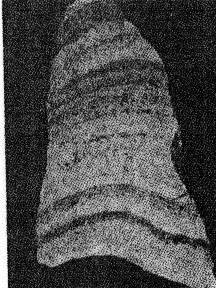
FIG. 8. Specimen from younger dike showing banding. One-fourth natural size.
BANDING
A distinct banding of the minerals was noted in at least six of the dikes, and
is especially prominent in dikes 4, 8, and 25. The bands are parallel to each
other, but unequal in their thickness, which ranges from 1 mm. to 15 cm. The
thickness of a single band is very uniform for several meters. Many bands are
wavy, especially in a direction parallel to the strike of the dike. The dip
roughly conforms to that of the dike. The zones of banding may be in any part of
the dike, but are near the center in most cases. There may be as many as three
of these zones separated by areas of coarsely crystalline microcline, quartz and
muscovite. The banded zones do not extend throughout the entire length of every
dike.
The minerals in the banded zones are very fine grained, giving the rock a
saccharoidal texture. The most common minerals in the bands are cleavelandite,
quartz, garnet, muscovite, and lesser amounts of tourmaline, apatite and beryl.
The contact between the various bands is not sharp, but gradational. The red
bands are caused by a concentration
of garnets, but many garnets are also found scattered throughout the white zones
of cleavelandite.
Banding in igneous rocks has been explained as due to either gravity separation
or rhythmic precipitation. Gravity separation could not have been the cause in
these dikes for the minerals are not banded according to specific gravity. Bands
of any type can be found in any part of a dike.
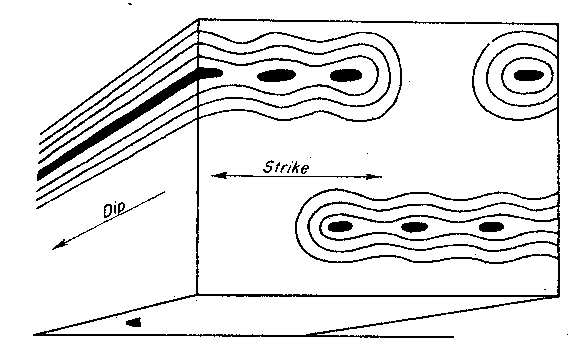
FIG. 9. Block diagram showing formation of bands concentric about finger-like
openings.
The remarkable paralellism of the bands, the waviness of the bands in a
direction parallel to the strike of the dike, and the less wavy character in a
direction parallel to the dip of the dike indicate the development of the bands
by a "rhythmic precipitation" similar to Liesegang rings (17).
Hydrothermal solutions, rising along tubular or finger-like fractures elongated
parallel to the dip of the dike, precipitated material in parallel bands
concentric about these elongate fractures or openings. Because these openings
were almost infinitely longer than wide, the bands are straight in a direction
normal to the strike and irregular in a direction parallel to the strike of the
dike. This view is also supported by the fact that the bands are persistent
along the dip of the dike but not along its strike.
The sharpness of the bands would depend upon the physical character of the dike
rock and the chemical composition of the ascending solutions. The high
temperatures and pressures associated with such mineralization would also affect
the physical condition of the resulting bands.
PARAGENESIS
The paragenetic relationships could not be determined for all of the minerals.
Not all of the minerals were found in any single dike, so the time relationships
between some minerals could not be checked. The mineralization can be roughly
divided into seven stages:
1. Magmatic stage. Quartz and microcline, and perhaps a small amount of
muscovite, were precipitated from the primary pegmatite magma. Because the dikes
which have been subjected to hydrothermal alteration contain much more muscovite
than do the unaltered dikes, the muscovite must be dominantly hydrothermal. The
microcline and quartz were precipitated almost simultaneously, for every
specimen shows mutual boundaries between these minerals. The muscovite is later
than either the microcline or quartz.
2. Muscovitization. Intrusion of the magma was followed by replacement of part
of the microcline and quartz by muscovite. Blades of muscovite transect both the
microcline and quartz.
3. Lithium phase. The lithium phase is generally a late hydrothermal stage, but
in these dikes the petalite is completely replaced by cleavelandite, so the,
lithium phase must be pre-albite in age. The minerals, lepidolite, petalite and
amblygonite were deposited in a few dikes at this time.
4. Albitization. Almost every dike was partly or entirely replaced by
cleavelandite. Crystals of this mineral transect microcline, quartz and
muscovite, and replace large masses of petalite.
5. Other hydrothermal minerals. Because of lack of association, many minerals
could not be arranged in a definite order based on time of formation. Some of
these minerals were probably precipitated simultaneously and all of them
transect blades of cleavelandite. They include tourmaline, apatite, beryl,
garnet, columbite, tantalite and braunite.
6. Primary sulphides. Chalcopyrite is found in a vein of quartz in one dike.
Because quartz is the only other mineral present, the age of the Chalcopyrite
cannot be determined.
7. Supergene minerals. Quartz, sericite, malachite and limonite were deposited
by later supergene mineralization.
The minerals are listed in the following table as nearly as possible in the
order of their formation.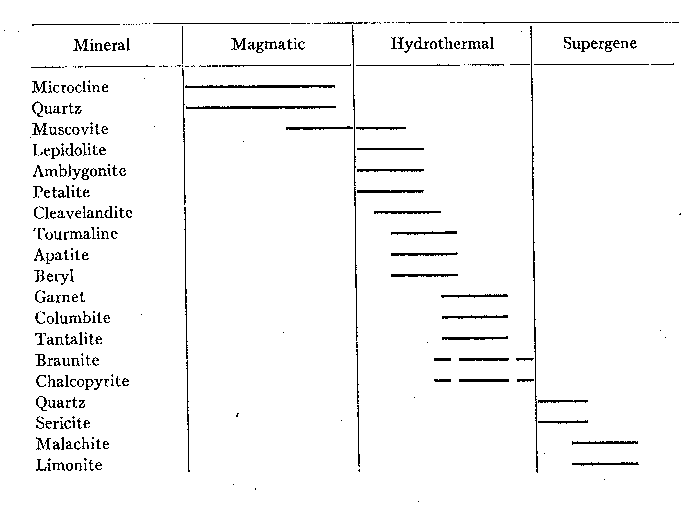
REPLACED SCHIST
North of section 27 in Hoodoo Canyon and in adjacent regions are several large
areas of replaced schist. The country rock has been partly or completely
replaced by later hydrothermal mineralization. The altered schist varies in
color from gray to almost snow white. The areas are generally 12 to 16 meters
wide, and all are less than 200 meters in length. The altered schist strikes and
dips in the same direction as the original black schist. The change from
completely replaced schist to unaltered material is quite abrupt, the entire
transition taking place within a distance of 3 meters. The areas are bounded on
all sides by unaltered hornblende schist.
Microscopic studies of thin sections of these rocks show almost complete
replacement by quartz, sericite and muscovite. Several specimens contained more
than 95 per cent quartz, and another showed at least 90 per cent sericite. Only
slight indications of the original character of the rock were found. Almost
every thin section contained grains of zircon similar to those found in the
hornblende schist. Quartz is the dominant mineral in the specimens taken from
the areas of replaced schist. It constitutes from 10 to 98 per cent of the rock.
Sericite and quartz together in most cases make up 98 per cent of the entire
rock specimen.
Because of the great extent of the replaced area in a direction parallel to the
strike of the schist compared with the very limited extent normal to the strike, and the existence of similar alteration of the country rock above
and adjacent to the older dikes in sections 27 and 28, it is logical to conclude
that this replacement is due to the activity of silica-rich solutions which
followed the intrusion of dikes parallel to the foliation of the schist.
Solutions could travel great distances in the plane of the foliation, but would
be unable to penetrate the impervious layers in a direction normal to the plane
of the foliation of the schist.
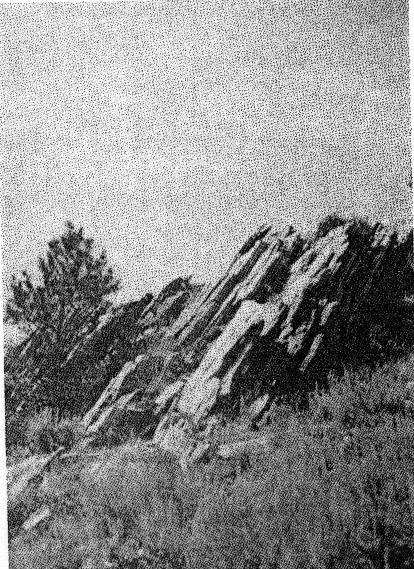
FIG. 10. Steeply dipping replaced schist.
The gently dipping joint system which strikes normal to the schistosity, and
along which the younger dikes were intruded, is also present in the replaced
schist. These joints were obviously formed after the replacement of the schist
had taken place, for, if they had been present, the solutions would have
traveled a greater distance in a direction normal to the strike of the schist.
The replacement is probably closely associated with the intrusion of the older
dikes which parallels the foliation of the schist.
HISTORY OF MINERALIZATION
The history of mineralization of this area may be summarized as follows:
1. Intrusion or extrusion of a mafic igneous magma into or upon the country
rock. Microscopic examinations of thin sections of the black schist indicate a
derivation from an igneous rock chemically and mineralogically similar to a
diorite, or possibly a basalt. The fact that the black schist is fine grained
leads one to conclude that the original, igneous rock was also fine grained or
perhaps aphanitic.
2. Regional metamorphism of the igneous rocks. Great pressures applied to these
rocks caused a transformation of the diorite, or basalt, into a fine grained
hornblende schist.
3. Intrusion of red granite. The granite is very coarsely crystalline and was
probably intruded at great depth.
4. Development of the vertical jointing system. These nearly vertical joints are
parallel to the foliation of the schist and extend from the schist out into the
red granite and were; therefore, developed after the intrusion of the granite.
5. Intrusion of older pegmatite dikes along the vertical jointing system. The
older dikes were intruded into the black schist and into the adjacent masses of
coarse grained red granite. The magma soaked and forced its way through the
black schist; in several places the contact between dike and schist is
gradational. Considerable force also accompanied the intrusion, for in several
places the foliae of the schist have been bent by the forceful intrusion of the
dikes.
6. Replacement of the schist adjacent to the dikes by highly attenuated silica-
and potash-rich hydrothermal solutions which deposited quartz and sericite.
These solutions traveled along the vertical joints and foliation of the schist
and replaced the schist rather than the minerals in the dikes.
7. Development of the second and nearly horizontal joint-set. Because the schist
is replaced for a great distance in a direction parallel to the strike of the
schist and for only a very short distance normal to the schist's foliation, it
is apparent that these joints were developed after the replacement of the
schist.
8. Intrusion of younger dikes took place along the second set of joints. The
magma must have been more viscous than that which formed the older dikes because
there was no soaking up of the schist by the younger dikes, and the crystals are
not quite as large.
9. Hydrothermal replacement of the younger dikes. Later hydrothermal solutions
replaced parts of the dikes and, in a few places, the adjacent schist.
10. Removal of the overlying country rock by erosion.
11. Supergene mineralization. This is represented by the deposition of later
sericite, the oxidation of chalcopyrite to malachite and limonite, and the
incipient kaolinization of feldspar.
REFERENCES
1. Bastin, E. S., Chemical composition as a criterion in identifying
metamorphosed sediments: Jour. Geol., 21, 193--201 (1913).
2. Blackwelder, Eliot, Summary of the pre-Cambrian rocks of Utah and Wyoming:
Utah Sci. Proc., 12,153 (1935).
3. Carlson, C. G., A test of the feldspar method for the determination of the
origin of metamorphic rocks: Jour. Geol., 28, 632-642 (1920).
4. Coats, R. R., Primary banding in basic plutonic rocks: Jour. Geol., 44,
407-419 (1936). 5. Goldschmidt, Victor,
Index der Krysiallformen der Mineralien,
Band 3, 193-194 (1891). 6. Gwynne, C. S., Granite in the Wind River Canyon,
Wyoming: Bull. Geol. Soc. Am., 49, 1417-1424 (1938).
7. Harker, Alfred, Petrology for Students, 224-226; 316 (1908).
8. Hess, F. L., Tin, tungsten and tantalum deposits of South Dakota: U. S. Geol.
Survey, Bull. 380, 131-163 (1909).
9. Hess, F. L., The natural history of pegmatites: Eng. and Mining Jour. Press,
120 (8), 289-298 (1925).
10. Hintze, Carl, Handbuch der Mineralogie, Band 1, Abteilung 4, Zweite Halfte,
437-483. 11. Johnson, J., and Niggli, Paul, The general principles underlying
metamorphic processes: Jour. Geol., 21, 281-516 (1913).
12. Kemp, J. F., The role of igneous rocks in the formation of veins: A. I. M.
E. Trans., 31, 182 (1901).
13. Kemp, J. F., The after effects of igneous intrusion: Bull. Geol. Soc. Am.,
33, 231-254 (1922).
14. Landes, K. K., Origin and classification of pegmatites: Am. Mineral., 18,
(1933).
15. Leith, C. K., and Mead, W. J., Metamorphic studies: Jour. Geol., 23, 600-607
(1915). 16. Leith, C. K., and Mead, W. J.,
Metamorphic Geology, Part 3, Chap. 1
(1915).
17. Liesegang, R. E., Geologische Diffusionen, 1913, p. 180. Reviewed by A.
Knopf in Econ. Geol., 8, 803--806.
18. Schaller, W. T., Mineral replacements in pegmatites: Am. Mineral., 12, 59-63
(1927). 19. Schwartz, G. M., Hydrothermal alteration of igneous rocks:
Bull.
Geol. Soc. Am., 50, 192-194 (1939).
20. Shand., S. J., The Study of Rocks, Chapter 15, 211-224 (1931).
21. Simpson, E. S., Contributions to the mineralogy of Western Australia, Series
XI: Jour. Royal Soc. West. Australia., 24, 116-121 (1938).
22. Trueman, J. D., The value of certain criteria for the determination of the
origin of foliated crystalline rocks: Jour. Geol., 20, 228-258 (1912).
23. Weed, W. H., The Role of the Volatiles in Ore Genesis: Privately published,
50 pp. (1933).
24. Williams, G. H., The greenstone schist areas of the Menominee and Marquette
regions of Michigan: U. S. Geol. Survey, Bull., 62, 217 (1890).
NOTES
* A portion of a Ph.D. thesis, University of Kansas, 1939.
Footer for links and copyright
|

